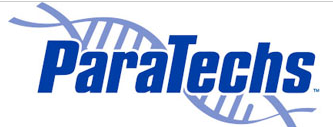
The NSET™ Device is manufactured in the USA by an FDA Registered Medical Device Manufacturer and ISO 13485:2003 Registered Company and is EtO (Ethylene Oxide) sterilization processed. Patent Information: Non-Surgical Embryo Transfer Method and Apparatus, United States Patent 9,615,903.[PDF]
A video demonstrating the use of the NSET device for mice can be found below.

Click on the Merit Ribbon to view our Award Winning Poster during D5 AALAS 2014, Stone B. (2014) “A Non-surgical Uterine Transfer Technique for Mouse Embryos after Cryopreservation, In Vitro Fertilization, ES-cell Injection, and Sperm during Artificial Insemination.”
Non-Surgical Embryo Transfer Device for MicePlace an order by completing the PDF order form and returning it to ParaTechs. All prices are USD. Shipping and Handling are added to invoice at time of processing. | |||
| Product number: 60010 | 10 Devices/box | 1-9 boxes = $250 ea.10-49 boxes = $225 ea.50+ boxes = $200 ea. |  |
The NSET Demonstration VideoThe demonstration video can be downloaded. This video demonstrates how easily mouse uterine embryo transfer can be accomplished using the NSET™ (Non-Surgical Embryo Transfer) Device for Mice.
ParaTechs’ Non-Surgical Embryo Transfer (NSET™) Device revolutionizes mouse uterine embryo transfer by reducing cost and eliminates the need for animal anesthesia and recovery normally required for conventional surgical procedures.
Uses•Embryo transfer after DNA microinjection•ES cell chimeric blastocyst transfer•Cryopreserved embryo transfer•Embryo transfer after in vitro fertilization•Embryo transfer for rederivation•Pathogen or material transfer to uterine horn•Sperm transfer for artificial insemination (AI) | Advantages•Eliminates the pain and distress of surgery•No anesthesia required•Eliminates need for post-surgical monitoring of animals•Reduces regulatory burden by eliminating need to justify survival surgery•Eliminates surgical instruments and time-consuming pre- and post-surgical processes•Greatly reduces time required to become proficient in embryo transfer or artificial insemination (AI)•Reduces costs of embryo transfer•Reduces costs of artificial insemination (AI) |
Compare this methodology with the time, expense, and training required to accomplish the same task with other methods and you will discover it is humane, quick and cost effective.
• NSET Technical Support Letter [PDF Only]
• NSET Instructions [PDF] REVISED JAN2016
• NSET Helpful Hints [PDF] REVISED JAN2016
• NSET Frequently Asked Questions [PDF] REVISED JAN2016
• NSET Publications
• NSET Presentations
(back to top)
ebiomall.com






>
>
>
>
>
>
>
>
>
>
>
>
加样缓冲液的主要作用是使PCR产物与其混合,使DNA沉于加样孔的底部,防止DNA跑出来.
拼音名:Chunhuashui
英文名:PurifiedWater
【性状】本品为无色的澄清液体;无臭,无味。
【检查】酸碱度取本品10ml,加甲基红指示液2滴,不得显红色;另取10ml,加溴麝香草酚蓝指示液5滴,不得显蓝色。氯化物、流酸盐与钙盐取本品,分置三支试管中,每管各50ml。第一管中加硝酸5滴与硝酸银试液1ml,第二管中加氯化钡试液2ml,第三管中加草酸铵试液2ml,均不得发生浑浊。
硝酸盐取本品5ml置试管中,于冰浴中冷却,加10%氯化钾溶液0.4ml与0.1%二苯胺硫酸溶液0.1ml,摇匀,缓缓滴加硫酸5ml,摇匀,将试管子50℃水浴中放置15分钟,溶液产生的蓝色与标准硝酸盐溶液[取硝酸钾0.163g,加水溶解并稀释至100ml,摇匀,精密量取1ml,加水稀释成100ml,再精密量取10ml,加水稀释成100ml,摇匀,即得(每1ml相当于1pgNO3)0.3ml,加无硝酸盐的水4.7ml,用同一方法处理后的颜色比较,不得更深(0.000006%)。
亚硝酸盐取本品10ml,置纳氏管中,加对氨基苯磺酰胺的稀盐酸溶液(1→100)lml与盐酸菜乙H肢溶液(0.l+100)1ml,产生的粉红色,与标准亚硝酸盐溶液〔取亚硝酸钠0.750g(按干燥品计算),加水溶解,稀释至100ml,摇匀,精密量取1ml,加水稀释成100ml,摇匀,再精密量取1ml,加水稀释成50ml,摇匀,即得(每1ml相当于1μgNO2)]0.2ml,加无亚硝酸盐的水9.8ml,用同一方法处理后的颜色比较,不得更深(0.000002%)。
氨取本品50ml,加碱性碘化汞钾试液2ml,放置15分钟;如显色,与氯化铵溶液(取氯化铵31.5mg,加无氨水适量使溶解并稀释成1000ml)1.5ml,加元氨水48ml与碱性碘化汞钾试液2ml制成的对照液比较,不得更深(0.00003%)。
二氧化碳取本品25ml,置50ml具塞量筒中,加氢氧化钙试液25ml,密塞振摇,放置,小时内不得发生浑浊。
易氧化物取本品100ml,加稀硫酸10ml,煮沸后,加高锰酸钾滴定液(0.02mol/L)0.10ml,再煮沸10分钟,粉红色不得完全消失。
不挥发物取本品100ml,置105℃恒重的蒸发皿中,在水浴上蒸干,并在105℃干燥至恒重,遗留残渣不得过1mg。
重金属取本品50ml,加水18.5ml,蒸发至20ml,放冷,加醋酸盐缓冲液(pH3.5)2ml与水适量使成25ml,加硫代乙酰胺试液2ml,摇匀,放置2分钟,与标准铅溶液1.5ml加水18.5ml用同一方法处理后的颜色比较,不得更深(0.00003%)。
微生物限度取本品,采用薄膜过滤法处理后,依法检查(附录ⅪJ),细菌、霉菌和酵母菌总数每1ml不得过100个。
【贮藏】密闭保存。
【化学成分】本品为蒸馏法、离子交换法、反渗透法或其他适宜的方法制得的供药用的水,不含任何附加剂。
【分子式与分子量】H2O18.02
【药理作用】溶剂、稀释剂
这里药典纯化水标准中并无PH值项目,请问对纯化水有PH值的要求吗,范围应在多少?请说明出处?
在纯化水检测中,检验酸碱度合格,但是发现PH在8左右。如果按以上标准检验合格,是否要考虑PH值?请知道的解答,谢谢!
Tris-Glycine/SDS;
MOPS/SDS;
Bis-Glycine/SDS等不同的缓冲液、预混液等。
不知道这几种缓冲液有什么异同呢?
比如如果是Invitrogen的预制胶-预混液电泳系统,每种预制胶有适配缓冲液,但是如果用其他的缓冲液似乎也可以得到不错的结果,那么是否说明电泳缓冲液只要满足了缓冲ph范围,其他的不是特别重要呢?
此外,附加提问是,PVDF膜在转膜的时候,转膜缓冲液中不需要加入甲醇,那么是加入甲醇转膜效果好还是不加好呢?
谢谢!
这就是说不用酸碱预处理吗?
Whatman的网站上没有DE52最大耐受压力,请问又经验的战友应该是多少?
Whatman的网站上:
DE32DryMicrogranularDEAECellulose
SimilarperformancecharacteristicsafterprecyclingasDE52.
DE52PreswollenMicrogranularDEAECellulose
ProbablythemostwidelyusedDEAEcelluloseintheworld;usedforbiopolymerswithlowtohighnegativecharges;exhibitsexcellentresolutionwithgoodflowrates.
附件是一本图书(MethodsinMolecularMedicine,)的章节,上面说:
WhatmanDEAE52comesalreadypreswollenandonlyneedstobetransferred
totherunningbuffer50mMTE8.
lAntibodiesUsingIonExchangeChromatography.pdf(87.06k)
1mol/l Tirs-HCl(PH8.8) 0.6ml
10%SDS 2ml
50%甘油 5ml
2-巯基乙醇 0.5ml
1%溴酚兰 1ml
水 0.9ml
另外:SDS不好溶解建议加热溶解,如果要做非还原SDS-PAGE请将2-巯基乙醇 0.5ml换成超纯水即可
是否可以理解为纯化水得PH范围为6.3-7.6?能否直接用pH计测量?谢谢!









